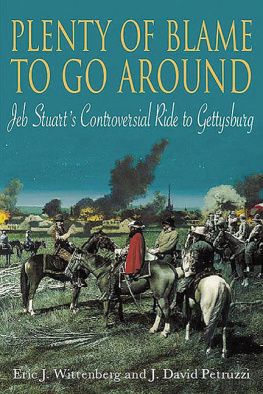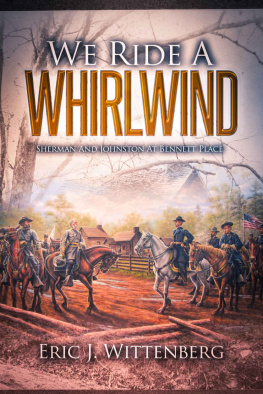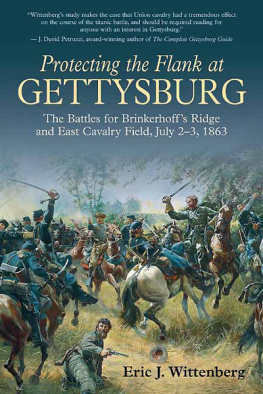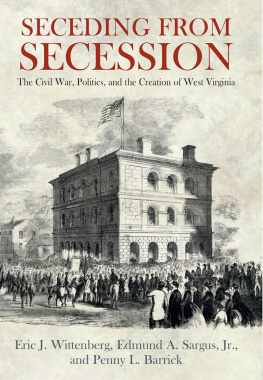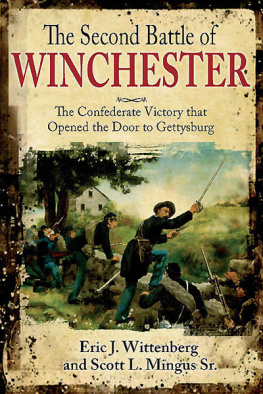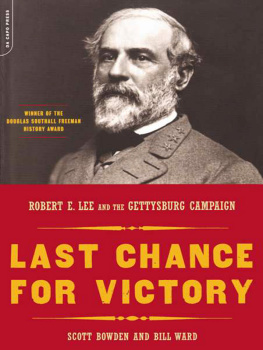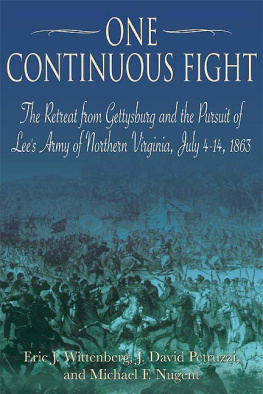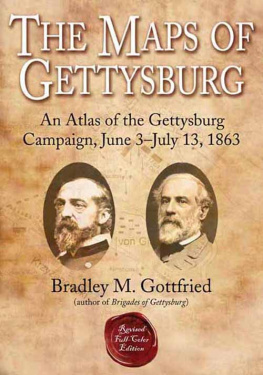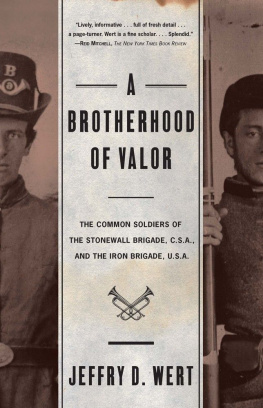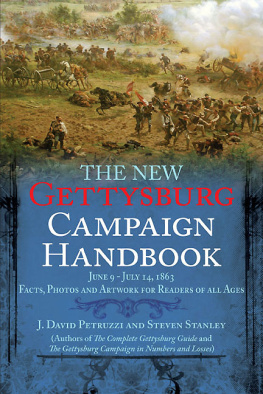

2006 by Eric J. Wittenberg & J. David Petruzzi
All rights reserved. No part of this publication may be reproduced, stored in a retrieval system, or transmitted, in any form or by any means, electronic, mechanical, photocopying, recording, or otherwise, without the prior written permission of the publisher. Printed in the United States of America.
Cataloging-in-Publication Data is available from the Library of Congress.
ISBN: 1-932714-20-0
Digital Edition ISBN: 978-1-61121-017-0
05 04 03 02 5 4 3 2 1
Second edition, second printing

Published by
Savas Beatie LLC
521 Fifth Avenue, Suite 3400
New York, NY 10175
(E-mail) editorial@savasbeatie.com
Savas Beatie titles are available at special discounts for bulk purchases in the United States by corporations, institutions, and other organizations. For more details, please contact Special Sales, P.O. Box 4527, El Dorado Hills, CA 95762, or you may e-mail us at sales@savasbeatie.com, or visit our website at www.savasbeatie.com for additional information.
Cover Art: The Shelling of CarlisleJuly 1-2, 1863, by Ron Lesser. 2003 Ron Lesser. All rights reserved.
The original oil painting was commissioned by F&M Trust of Chambersburg, Pennsylvania, for the 2003 Commemoration of the 140th Anniversary of J.E.B. Stuarts Shelling of Carlisle in July 1863. The painting (41 27) is in the permanent collection of the Cumberland County Historical Society in Carlisle. Limited Edition prints are available at the society or through the Chambersburg Heritage Center, Chambersburg, Pennsylvania. For more information on the artist, please go to www.ronlesser.com.
This book is dedicated to the memory of the men of both sides who followed the guidon.
It is also respectfully dedicated to the memory of Brian C. Pohanka, historian, mentor, preservationist, and friend. Your wise counsel will be missed.
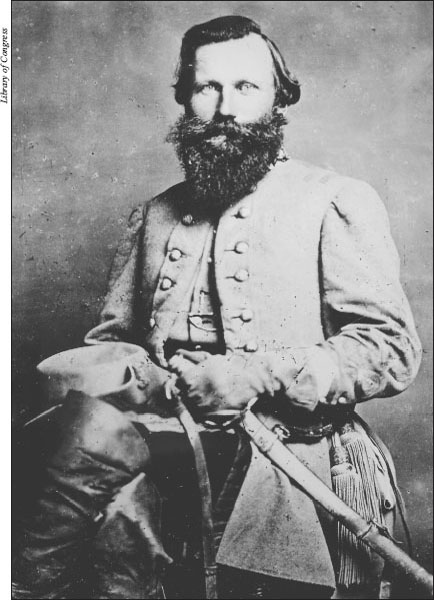
Major General James Ewell Brown (JEB) Stuart, General Lees cavalry chief and commander of the expedition.
Preface
The Gettysburg Campaign has had more than its share of controversies, many of which began before the guns fell silent. From the time the confident and stalwart Jeb Stuart was surprised by Alfred Pleasontons Union troopers at Beverly Ford in the predawn of June 9, 1863, near Brandy Station, Virginia, until after Stuarts arrival on the Gettysburg battlefield late on the afternoon of July 2, the Southern cavalry chieftain was the subject of much chatter among the Confederate upper crust. Not much of it was complimentary. Southern newspapers lambasted Stuart for allowing himself to be surprised by the Federals at his own headquarters on Fleetwood Hill, and tongues wagged among the infantry that perhaps Stuart was not up to his former game.
Debate over the merits and results of Stuarts ride to Pennsylvania was, and still is, a virtual cottage industry. Not long after the war, as Gettysburg evolved into the battle that lost the war (whether justified or not), arguments raged among veterans in newspapers, magazines, articles, books, and face-to-face. Non-veteran commentators of all types got in on the act.
Any serious treatment of the Gettysburg Campaign must, out of sheer necessity, mention in some form the impact Stuarts ride had on the outcome of the three-day conflagration in Pennsylvania. Today, an increasingly educated reading public demands it. To do otherwise is to leave a gap so large that the work itself will collapse into it, leaving the reader feeling somehow unfulfilled. Discussions about Stuart and his proud horsementhe eyes and ears of Robert E. Lees armyand their detachment from it during the ride north have become an integral thread in the fabric known as the Gettysburg Campaign.
In fact, entire books have been devoted to this subject. In the middle of the postwar controversy among the veterans came John Singleton Mosbys Stuarts Cavalry in the Gettysburg Campaign (1908). An icon of the Confederacy and southern pluckand one of Stuarts most stalwart supportersMosby argued for Stuarts case as well as any lawyer could hope. As would be expected, the appearance of the book stirred up the hornets nest anew and left surviving veterans (notably officers who had served under Lee and Stuart) and anyone else with an opinion, freshly invigorated to debate the issues in public speeches and a new round of newspaper articles.
More recently, Mark Nesbitt, in Saber and Scapegoat: J.E.B. Stuart and the Gettysburg Controversy (1994) took up Stuarts defense with fresh perspectives on the tactics of Stuarts ride and the ensuing debates between the cavaliers supporters and detractors. In many ways Nesbitts book updated Mosbys work but missed out on many primary sources that have surfaced in the years since the publication of the partisans tome in 1908. Because of this, we concluded there was more work yet to be done in order to tell this story as fully and as completely as it deserves.
We did not set out to write a book that dealt so heavily in the controversy itself. Our initial intention was to produce a detailed tactical treatment of the battles and skirmishes that Stuarts brigades fought along the way to Gettysburg, with but a cursory discussion of the controversy in a final chapter. Although several good articles and books have recently appeared dealing with Stuarts scraps with Federal cavalry during his ride, we were aware of many untapped resources in manuscript collections, historical repositories, and veterans memoirs and letters that were not fully utilized, if utilized at all. We have been collecting these sources jointly and separately over a combined thirty years of studying these actions. Even George Rummels wonderful and indispensable book Cavalry on the Roads to Gettysburg: Kilpatrick at Hanover and Hunterstown (2000) doesnt take advantage of many of these resources. Precious little has been written about the fight at Westminster or the shelling of Carlisle. Nothing at all has been written about the critical skirmish at Fairfax Court House, which occurred even before Stuart crossed the Potomac River. And so we set out to write a detailed study of the entirety of Stuarts advance to Pennsylvania using every reliable resourcethe more obscure the betterwe could find, and leave much of the controversy for perhaps another book.
About halfway into the project, however, we quickly realized that the magic and mystery of those days drew us in like a spiders web; we were joyfully stuck in its grasp with no hope of escaping. As we found more and more sources (many of which began to change and enhance our opinions), and delved deeper into the tactics and mechanics of the ride, we discovered we could not separate the tactical treatment from the controversy and do either one of them justice. We therefore determined to take this book to the level at which we now present it to you.
We think we have prepared the most detailed tactical discussion of these events ever attempted, and draw upon a myriad of published and unpublished primary and secondary sources to do so. Those sources helped us flesh out these events and bring them to life. We have also tackled the controversy that has evolved over the yearsmuch more deeply than we had originally intended. After much discussion, we decided to include the words of the various commentators who have addressed the raid verbatim, so that our readers can determine the merits of their arguments for themselves. Three full chapters are devoted to the controversy. The first deals with early critics, the second with early supporters, and the third with how modern historians and writers interpret these events. We conclude with our own analysis of these events, all of which taken together give rise to the title of this book. We have amply illustrated the book with photos of participants, important locations, and contemporary illustrations. A number of detailed maps have been included to help readers better understand the narrative.

